Please Take Note: This is a review of the final game, but it might change slightly based on the success of the Kickstarter campaign. The game is being reviewed on the components and the rules provided with the understanding that “what you see is not what you might get” when the game is published. If you like what you read and want to learn more, we encourage you to visit the game’s website or visit the Kickstarter campaign. Now that we have all that disclaimer junk out of the way, on with the review.
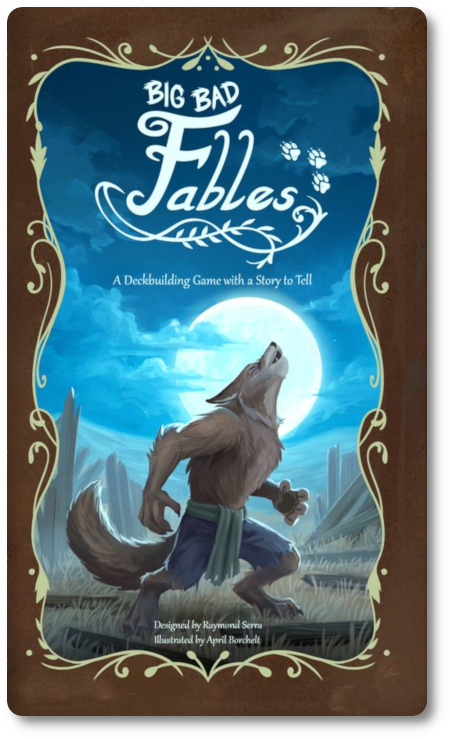
The Basics:
- For ages 10 and up (publisher suggests 12+)
- For 1 to 4 players
- Approximately 30 minutes to complete
Geek Skills:
- Active Listening & Communication
- Counting & Math
- Logical & Critical Decision Making
- Reading
- Hand/Resource Management
Learning Curve:
- Child – Easy
- Adult – Easy
Theme & Narrative:
- Build your house as quickly as you can before it all gets blown down!
Endorsements:
- Gamer Geek rejected!
- Parent Geek mixed!
- Child Geek approved!
Overview
American entrepreneur, animator, voice actor, and film producer Walt Disney said, “All cartoon characters and fables must be an exaggeration and caricatures. It is the very nature of fantasy and fable.” Stories capture our imagination and serve to not only entertain, but to teach. Embedded in the stories we were told as children are lessons to learn. Danger and hope lurk in our nursery rhymes and fables. There are monsters and heroes. In this game, the Big Bad Wolf is out-and-about, but safety can be had if a sturdy house is built.
Big Bad Fables, designed and to be self-published by Raymond Serra, will reportedly consist of 17 Advanced Fable cards, 28 Novice Fable cards, 41 Saga Fable cards, 40 Starter cards, 16 Broken Pieces cards, and 48 Building cards. As this is a review of the prepublished version of the game, I cannot comment on the game component quality. Illustrations to be provided by April Borchelt are colorful and clean, giving each card a strong visual element to further reinforce the game’s theme and narrative.
Getting Your Fable On
To set up the game, first shuffle the Building cards and deal two rows of five cards each, face-up. Now do the same for a third row starting with Broken Pieces followed by Saga cards. These rows are referred to as the “Market.”
Second, shuffle the Fable cards and draw two, placing them in a row face-up. The type of Fable cards used is dependent on the game’s difficulty determined by the players. Novice Fable cards are the easiest, Standard Fable cards provide players more depth and complexity, and Advanced Fable cards will challenge players a good deal more. Place all remaining cards face-down next to the rows. This is the Market draw deck.
Third, give each player seven “Doormouse” and three ‘This Little Piggy” Starter cards. Have all players shuffle their cards and place them face-down in front of them. This is the players’ draw deck.
That’s it for the game set up. Have each player draw five cards from their draw deck, determine who will go first, and begin!
Once Upon a Time…
Big Bad Fables is played turns with no set number of turns per game. A player’s turn is summarized here.
Note: The number of Fable cards in the game is small at first. The first player, during their turn, will add a Fable card to the row, followed by the second player doing the same. This continues until the total number of Fable cards in the row is five. For the duration of the game, the Fable row will continue to have five cards.
Step One: Play Cards
All the actions the player can take on their turn are described on the cards in their hand, and there is no limit to the number of cards played on the player’s turn. All players should intend to build their houses as quickly as possible to avoid the Big Bad Wolf. To that end, there are two resources available to the players in the game. These are Cheese and Hammers. Cheese is used as the primary currency in the game, used to purchase cards from the Market. Hammers are used to build Building cards.
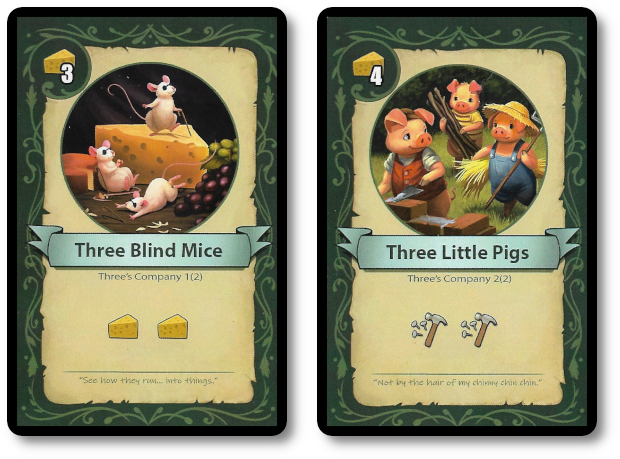
If a player buys cards from the market (cost of cards are noted in their corners), they play in front of them the cards from their hand that provide the appropriate number of Cheese to purchase. Players must always, at minimum, pay the listed amount. If they go over, the player does not get any Cheese back (thus allowing the player to overpay). Purchased Fable cards immediately go to the player’s discard pile. The player then draws a new Fable card, placing it face-up in the open spot in the rows.
If a player builds part of their house, they play in front of them the cards from their hand that provides the appropriate number of Hammers. Again, players must always, at minimum, pay the listed amount. Built Building cards are placed in front of the player, face-up, and a new Building card is drawn to replace it.
All Houses (built via the Building cards), must start with a foundation first, followed by walls, and finally the roof. Also, all Houses must be made of a single material. Available materials include Straw, Wood, and Brick.
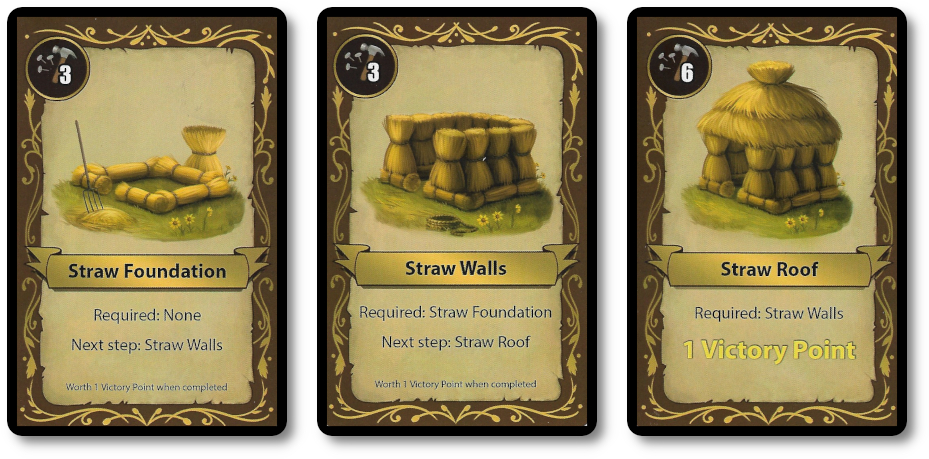
In addition to purchasing and building, players will have cards in their hand that allow them to impact the gameplay of their opponents and their turn. Some cards will give the player an extra action, for example. If the player has the cards in hand, they can “Cry Wolf” to adjust the Market or envoke “Big Bad Wolf” to take out an opponent’s house!
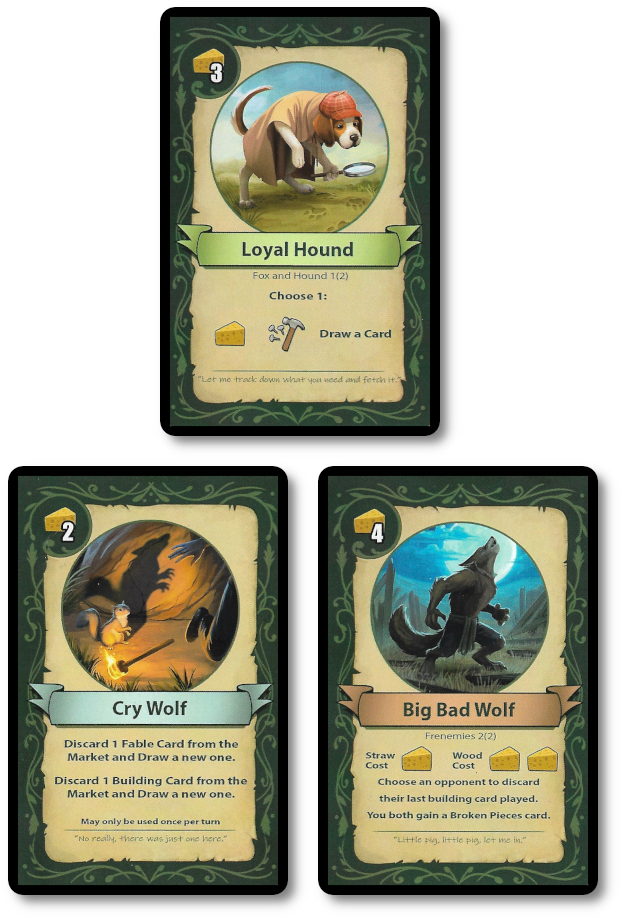
During the game, if both “Fairy Godmother” cards are in the Market at the same time, they fight (believe it or not). The result of their struggle is a magical explosion that temporarily swaps the standard rules for Cheese and Hammers. For example, players would typically use Cheese to buy Fable cards, but will temporarily use Hammers instead. This will affect the game for one round. After this, the magical blast fades, and the world returns to normal. Also, unless one of the “Fairy Godmother” cards is purchased before the round ends, one of the “Fairy Godmothers” is discarded.
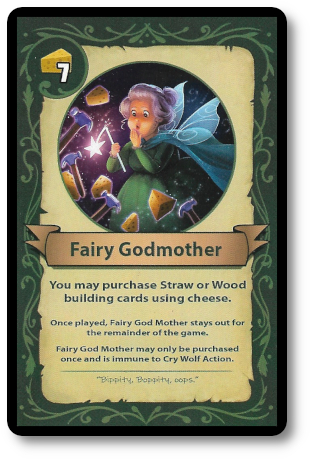
If playing the Advanced Fable game, players have on more trick they can pull on their turn. If they have the right number and type of cards in their hand during their turn, they can complete a “Story” by playing those cards in front of them. This is done before the player would take their normal turn. At the time of this review, there are six possible stories. The cards in the player’s hand will list the Story they are associated with, what number that card is, and the total number of cards needed to complete the story. If the player has the cards, they can play them out all at once to trigger the Story’s unique action. After the action is completed, the cards used go right back into the player’s hand to be played on their turn.

- Tea Party: Draw a card
- Three’s Company: Discard specific cards to gain an additional Hammer or Cheese resource
- Chocolate Frog: Purchase Fable cards from the discard pile for half their listed price
- Fox and Hound: Choose two instead of one card using the “Loyal Hound” card
- Just Right: Build three available House cards for free
- Frenemies: Collect a Broken Piece card (which can be used in the game to collect other cards)
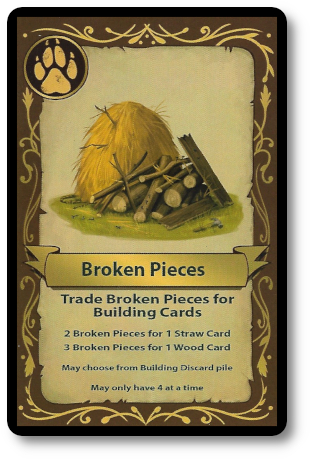
Step Two: Discard and Draw
After the player plays all their cards or decides that their turn is over, they take any cards remaining in their hand and any played cards (not built cards) and place them in their discard pile. The player then draws five new cards. If the player is unable to draw five cards, they shuffle their discard pile, turn it face-down, and use it as their new draw deck.
The End
This continues, as noted above, until the first player scores enough points to win. The number of points needed is based on the game’s difficulty. If playing with Novice Fable cards, the first player to score one point wins the game. When playing Standard and Advanced Fable cards, the first player to score three points wins the game.
Writing Your Own Story Alone (or With a Friend)
Big Bad Fables can be played with only one player or as a cooperative. When doing so, cards are drawn and resolved. The game’s goal is still the same, but players must be able to react to the Big Bad Wolf, or they will be eaten and lose.
To learn more about Big Bad Fables, visit the game’s website or visit the Kickstarter campaign.
Final Word
 The Child Geeks very quickly grasped the game’s rules and jumped right into the gameplay. I must say, I was very impressed with our younger players, as they seemed to have little to no difficulty at all with the game as a whole. As the game progressed, the reasons for this became apparent. According to one Child Geek, “I like how easy it is to see what you can buy and what you need to build. It makes the game easy and fun to play.” Another Child Geek said, “Nothing in the game made me angry or sad. I just liked building and a few times the wolf came out I was OK with it because I didn’t have a house yet that the wolf could get so it was fine and also I liked how the Godmothers fight in the game. That was funny.” And that was an extremely long quote! When all the stories were finished, the Child Geeks voted to approve Big Bad Fables.
The Child Geeks very quickly grasped the game’s rules and jumped right into the gameplay. I must say, I was very impressed with our younger players, as they seemed to have little to no difficulty at all with the game as a whole. As the game progressed, the reasons for this became apparent. According to one Child Geek, “I like how easy it is to see what you can buy and what you need to build. It makes the game easy and fun to play.” Another Child Geek said, “Nothing in the game made me angry or sad. I just liked building and a few times the wolf came out I was OK with it because I didn’t have a house yet that the wolf could get so it was fine and also I liked how the Godmothers fight in the game. That was funny.” And that was an extremely long quote! When all the stories were finished, the Child Geeks voted to approve Big Bad Fables.
 The Parent Geeks enjoyed playing the game with their Child Geeks, but their interest quickly faded when they played it among their peer group. According to one Parent Geek, “I really liked playing the game with the kids, but with adults, the game felt flat and not very interesting.” Another Parent Geek said, “Super easy to set up, teach, and play. Perfect for the family. We can all play the game without any problems. The game does a great job of keeping it all simple and visible, which is why it wasn’t a hit when I played it with just adults. Too simple and too obvious.” When the Parent Geeks closed the book, their ending for the game left it with a mixed endorsement.
The Parent Geeks enjoyed playing the game with their Child Geeks, but their interest quickly faded when they played it among their peer group. According to one Parent Geek, “I really liked playing the game with the kids, but with adults, the game felt flat and not very interesting.” Another Parent Geek said, “Super easy to set up, teach, and play. Perfect for the family. We can all play the game without any problems. The game does a great job of keeping it all simple and visible, which is why it wasn’t a hit when I played it with just adults. Too simple and too obvious.” When the Parent Geeks closed the book, their ending for the game left it with a mixed endorsement.
 The Gamer Geeks played and disliked the game. According to one Gamer Geek, “A great introduction to deck-building and little else. I like the concept of collecting sets, but the lack of true player interaction and absolutely no need for any strategy or tactics made the game a snooze fest for me.” Another Gamer Geek said, “Nice idea and well-executed. I think the game would do well at the family gaming table with very casual players and even players who have never played a deck-building game before. This is not a game for elitists or for anyone who has played deck-building games in the past. This is a beginner’s entry-level game at its best and its worst.” When all the votes were in, the Gamer Geeks found Big Bad Fables to be a dry story.
The Gamer Geeks played and disliked the game. According to one Gamer Geek, “A great introduction to deck-building and little else. I like the concept of collecting sets, but the lack of true player interaction and absolutely no need for any strategy or tactics made the game a snooze fest for me.” Another Gamer Geek said, “Nice idea and well-executed. I think the game would do well at the family gaming table with very casual players and even players who have never played a deck-building game before. This is not a game for elitists or for anyone who has played deck-building games in the past. This is a beginner’s entry-level game at its best and its worst.” When all the votes were in, the Gamer Geeks found Big Bad Fables to be a dry story.
 Big Bad Fables is a beginner’s deck-building game. Its rules are simple, the gameplay is straight forward, and the goal is visually reinforced via the house building. With our Child Geeks, this served to be a big hit. With most action taking place and focused on building and buying, the level of player interaction was minimal. This kept the players focused on the game’s goal without getting disrupted by their opponent too much.
Big Bad Fables is a beginner’s deck-building game. Its rules are simple, the gameplay is straight forward, and the goal is visually reinforced via the house building. With our Child Geeks, this served to be a big hit. With most action taking place and focused on building and buying, the level of player interaction was minimal. This kept the players focused on the game’s goal without getting disrupted by their opponent too much.
And at risk of being super cliché, the game’s biggest strength is also its greatest weakness. Because the game is perfect for beginners, it’s downright dull for advanced players. The game was found to be too linear and lacked depth. No complex strategy to be found. Nothing in the way of tactical methods to assault your opponent or build up your defenses. It just isn’t here. The game took the necessary parts to create the basic deck-building game and ignored the rest. The impact the few cards in the game have that allow you to mess with your opponent is inconsequential other than providing the player who used them a temporary feeling of pleasure for their turn only. Then, just as quickly as it was resolved, it goes away.
Big Bad Fables is a game I would recommend for families and suggest that casual and more advanced players look elsewhere for a deck-building game. If you have younger players or friends who have little no experience with deck-building games, Big Bad Fables is going to not only be a hit but a solid foundation on which to build a continued interest in the deck-building game mechanism. I was very impressed with how quickly our youngest players grasped the rules and ran with the game and just as equally distressed to see how fast casual and advanced players became bored. Big Bad Fables as a target audience. If you are it, do try this solid deck-building game for up-and-coming gaming geeks!
This is a paid-for review of the game’s final prototype. Although our time and focus were financially compensated, our words are our own. We’d need at least 10 million dollars before we started saying what other people wanted. Such is the statuesque and legendary integrity of Father Geek, which cannot be bought except by those who own their private islands and small countries.



